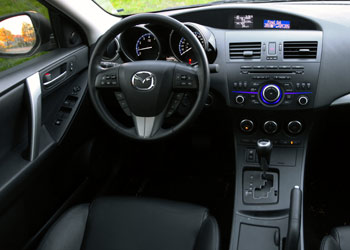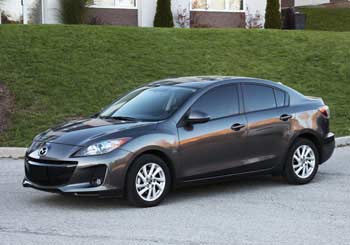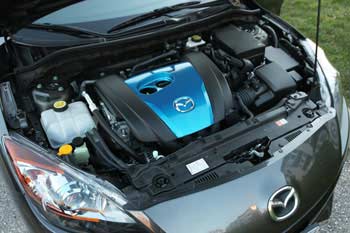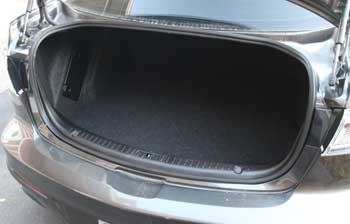Mazda 3 2010-2013: pros and cons, common problems
Updated: September 05, 2021
The sporty 2010-2013 Mazda 3 comes as a sedan or hatchback, with a 2.0L or 2.5L 4-cylinder engine and manual or automatic transmission.
The interior is stylish and nicely finished. The seats are comfortable and supportive, the steering tilts and telescopes.
Available features include heated leather seats, Bluetooth, push-button start, dual-zone climate control and navigation. The optional Bose 10-speaker audio system is one of the best you can find in a compact car. The Skyactiv technology package became available from 2012; the Mazda 3 with a 2.0L Skyactiv-G engine is one of the most fuel-efficient in its class. What are the pros and cons and reported problems?
Pros:
- The risk of expensive problems, such as the engine or transmission replacement is lower than average.
- It's a fun-to-drive, maneuverable little car; it's quick off the line and easy to control.
- The leather interior is one of the best among similar cars.
- Mazda 3 is good on gas, especially with the Skyactiv 2.0L engine.
- Easy to maintain and repair: Common repairs are not too expensive and any shop can handle them. This car is also easy to work on for a do-it-yourself person. 16-inch tires are not too expensive.
- The ride is sporty-firm and the interior is not very quiet.
- Rear tires will become cupped and noisy if not rotated regularly
- The seating position is low to the ground and the fabric seat material is not the best.
- The TCM may fail in non-Skyactiv models, wheel bearings, control arms, struts and shock absorbers are common to go bad.
Rear tires can wear unevenly on the inside and become "cupped" and noisy if not rotated in time. The rumbling noise from the tires may appear after the tire rotation, as cupped tires are more noisy when placed in the front. To avoid this problem, tires should be rotated at every oil change. Doing the wheel alignment may also help. The wheel alignment costs from $79 to $129.
HID headlights could fog up from the inside. When buying a used Mazda 3, it's best to avoid models with HID headlights as they are expensive to repair.
In early models with manual transmission, premature clutch failures have been reported by a number of owners. Replacing the clutch could cost from $900 to $1600. One of the signs of a worn out clutch is when it engages closer to the top of the pedal travel.
The issue with the headlights flickering while braking in the Skyactiv Mazda 3 can be resolved by reprogramming the engine computer with an updated software.
Leaking rear shock absorbers and front struts are not uncommon at higher mileage. Replacing rear shock absorbers costs from $130 to $190 per side. Replacing front struts is a it more expensive: $250-$400 per side. If the top mount of a rear shock absorber breaks off, it can be replaced separately. Aftermarket shock mounts are available and they are not very expensive.
Front lower control arms may also need to be replaced at higher mileage. Replacing both front control arms costs $480-$620. The wheel alignment might need to be performed after the front struts or control arms are replaced.
Advertisement
The steel lever that connects the automatic transmission shifter cable to the transmission may rust, causing the vehicle not to start in Park, but start in Neutral. The lever can be replaced or lubricated to solve the problem. The part is not expensive (around $20).
The transmission control module (TCM) may fail, causing the AT light to come on with the code for shift solenoids. The new TCM is expensive, but cheaper aftermarket units are available online. This problem affects a limited number of cars. The TCM is easy to replace, but it's important to verify that the part number is correct.
In Skyactiv models, the airflow sensor can fail, causing a no-start. The part is not expensive and the air flow sensor replacement is easy.
The hydraulic drive belt tensioner in Skyactiv 2.0L engine can fail (leak) and cause a rattling noise on acceleration. Replacing the belt tensioner together with the drive belt will cost $240-$320.
The Skyactiv engine has a direct fuel injection. As in any direct-injected engine, the carbon deposits on the valves and injectors can cause misfiring at higher mileage. Read more about direct fuel injection.
A failed ignition coil can cause the engine to misfire with codes P0301-P0304. Replacing an ignition coil is not very expensive.
The code P0442 could often be caused by a leaking Evap vent control valve (solenoid), although the Evap system must be tested to confirm it. The part is not expensive, but the replacement is not easy due to its location over the rear crossmember. ($250-$390 repair plus diagnostics).
Engine: The Mazda 3 comes with three engine choices. The base engine is a 2.0L MZR DOHC. It's a simple engine with a conventional fuel injection. It can last over 200,000 miles with regular maintenance. The 2.5L MZR DOHC is almost the same engine, but with more power.
The 2.0L direct-injected, high-compression Skyactiv-G engine, available from 2012, is much more technologically advanced and fuel-efficient. All three engines are very reliable and require minimum maintenance besides regular oil changes.
Timing belt or Timing chain: The 2.0L and 2.5L MZR, as well as the 2.0L Skyactiv engines have a timing chain; there is no timing belt.
Handling and ride: Mazda 3 is the benchmark for sporty handling and road feel among compact cars. The vehicle holds the road well on twisty roads and on the highway. The steering is precise and readily snaps back to center when driving straight. The turning radius is tight, which is a big plus. The ride is on the firm side and some road and tire noises are noticeable. Overall, Mazda 3 is a good choice for driving enthusiasts looking for a small fuel-efficient car.
Similar cars:
Honda Civic 2006-2011
Mazda 3 2004-2009
Chevrolet Cruze 2011-2015
Toyota Corolla 2009-2013
Toyota Matrix 2009-2014
Mazda 3 2014-2018
| Mazda 3 EPA Fuel Economy: | mpg city/hwy |
L/100 km city/hwy |
| 2011-2013 2.5L, manual | 20/28 | 11.8/8.4 |
| 2010 2.5L, manual | 21/29 | 11.2/8.1 |
| 2011-2013 2.5L, auto | 22/28 | 10.7/8.4 |
| 2010 2.5L, auto | 22/29 | 10.7/8.1 |
| 2011-2013 2.0L, auto | 24/32 | 9.8/7.4 |
| 2010 2.0L, auto | 24/33 | 9.8/7.1 |
| 2010-2013 2.0L, manual | 25/33 | 9.4/7.1 |
| 2012-2013 2.0L Skyactiv manual | 26/37 | 9.0//6.4 |
| 2012-2013 2.0L Skyactiv 5-door, auto | 28/37 | 8.4/6.4 |
| 2012-2013 2.0L Skyactiv 4-door, auto | 28/39 | 8.4/6.0 |
The Mazda 3 with a 2.5L engine is fast and has plenty of power, but it's not very good on gas. The 2.0L Skyactiv is the most fuel-efficient choice. Mechanically, Mazda 3 is a well-built car. It has a good engine, excellent brakes and strong suspension. Unlike the 2004-2005 models, this generation Mazda 3 is not affected by excessive rust issues. As of April 2020, Consumer Reports rates the 2010-2013 Mazda 3 as 'Recommended'. The Honda Civic is a similar car. Mitsubishi Lancer is sporty, but not very fuel-efficient. Ford Focus shares some of the powertrain components with Mazda 3 and is a similar car.
What to look for when buying a used Mazda 3: Check the service records to make sure the vehicle had been serviced in regular intervals. Test all the power options, CD changer, air conditioner and the sunroof. Watch out for uneven tire wear (typically on the inside). During the test drive, watch out for tire noise; cupped tires can cause a rambling or humming noise. Avoid the car if you notice blue smoke from the exhaust. If it's a manual car, make sure to test the clutch. Read more: How to inspect a used car - illustrated guide. Read also: What mileage is OK for a used car?
Maintenance: Change your engine oil at least every 5,000 miles or 8,000 km. For the 2010 Mazda 3, the 5W-20 is the recommended oil type. All 2011 and newer Mazda 3 models except Mazdaspeed 3 require synthetic 0W-20 oil. If you want your tires to last longer, rotate them at every oil change; if not rotated regularly, rear tires can become cupped and noisy. The cabin filter needs to be replaced at least every 25,000 miles (40,000 km) or two years. Transmission fluid needs to be changed when it becomes dirty. In all but Skyactiv models, you can check the transmission fluid condition using the transmission dipstick. Read more: how to check the transmission fluid condition.
| Overall | Frontal Crash |
Side Crash |
Rollover | |
| 2011 | ||||
| 2012 | ||||
| 2013 |
Skyactiv technology: Skyactiv is a collective name for the well-tuned package of technological advances that became available for 2012. Most impressive is the engine design, where better fuel economy is achieved without a hybrid drive or turbocharger.
With a higher compression ratio and direct injection, the Skyactiv engine can run on 87 gasoline. Read also: Pros and cons of buying a car with Direct Injection. The Skyactiv transmission is another interesting story. It delivers higher fuel efficiency without sacrificing the driving experience.
The Skyactiv gearbox is based on a traditional automatic transmission, something that is disappearing in many other cars. Another part of the Skyactiv package is a lighter and more rigid body and light-weight chassis.



